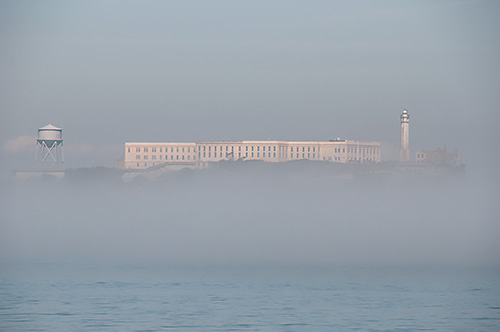Photo Corners headlinesarchivemikepasini.com
![]()
A S C R A P B O O K O F S O L U T I O N S F O R T H E P H O T O G R A P H E R
![]()
Enhancing the enjoyment of taking pictures with news that matters, features that entertain and images that delight. Published frequently.
Is The Print Primary?




12 March 2018
One of the benefits of attending a fair like Photofairs San Francisco is being exposed not just to thrilling images but interesting ideas. The panel discussion we attended was a bit short on the ideas themselves but gave us a few names to research. And that's where we found the ideas.

Alcatraz. Is it Alcatraz without the island?.
Take this quote from Museum of Modern Art curator Sarah Meister, for example:
In the digital era it strikes me as critically important to recognize the difference between a photograph (a physical object) and a photographic image (one that can assume new characteristics specific to the device on which it is seen, but which has no material presence) and that once you've really looked at a photograph you'll have new tools to approach both photographic objects and images.
She makes a distinction between the files we capture with our digital cameras and the prints that collectors chase and curators collect. And the distinction is that a file has "no material presence," taking on the "characteristics specific to the device on which it is seen."
This is a little like wondering, "Is Alcatraz prison Alcatraz without Alcatraz Island?"
But if a file has no material presence, why are we recovering highlights, shifting midtones, squeezing detail out of shadows, adjusting color temperature and performing all the other editing magic that consumes us?
As much as any print, the rendering of that JPEG represents a fully-articulated image.
So that our efforts can be distorted by whatever device displays the file?
When we edit an Raw file for display on Photo Corners we know it will be seen in a browser that may or may not read the color profile we assign to it. We know some readers will have calibrated monitors and others will be using the screen on their phone.
We don't shoot for the lowest common denominator. That takes care of itself. The JPEG we render will be visible one way or another.
But we do take care to develop that Raw file into an image that conveys what we intend. And we confirm that in our profile-aware browser on our calibrated screen. As much as any print, the rendering of that JPEG represents a fully-articulated image.
The problem is that the image optimized for viewing on a monitor can not be seen if turned into a print. A print, which absorbs and reflects light, doesn't have the range either in tone or color of a screen display's transmitted light.
So were we to print a portfolio of our best images, you'd have no idea what we're up to.
Curators have been deft at dealing with this issue when it comes to performance art or software-based art or even video. Collectors not so much. They need something tangible to possess and trade.
But back to the Alcatraz question.
We have a feeling you recognized Alcatraz without the island. In the same way you recognize that image as a photograph.
It may not be collectable. But we think it's possible to curate it. And high time.